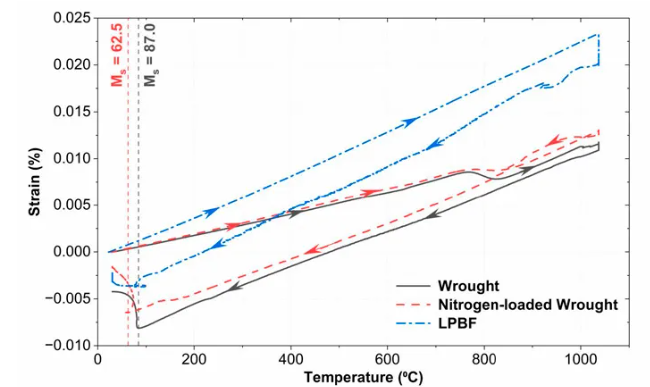Precipitation Hardened Stainless Steel

The wrought 17-4PH had a starting nitrogen content of 0.027 ± 0.0002 wt% N, the nitrogen-loaded wrought had 0.16 ± 0.004 wt% N, and LPBF had 0.13 ± 0.006 wt% N. Both wrought samples show similar slopes upon heating in the dilatometry curve (Figure 7) until a change in slope around 775°C, representing a phase transition. After quenching, both samples follow a new slope until a new change in slope at low temperatures, marking the martensite transformation. The point where this sharp transition begins can be labeled as the Ms temperature for that curve. The dilatometry curves for the wrought samples show that both started with a martensitic structure, transformed into austenite, represented by the steeper slope, and then transformed back into martensite. The LPBF curve maintains the steeper slope before and after quenching and shows no significant transformation curve. This suggests that the LPBF began with a primarily austenitic structure and did not reach its Ms temperature upon quenching.
The primarily austenitic structure is also reflected in the XRD results, plotted in Figure 8 below. Before heat treatment, LPBF displays intense austenite (γ) peaks and small ferrite (α) peaks. After heat treatment, the ferrite peaks become more prominent, but the austenite peaks remain, suggesting a partial martensite transformation. In comparison, the wrought 17-4PH has a completely martensite microstructure, as reflected by the intense ferrite peak.
Despite having a lower nitrogen content, the dilatometry curves show that LPBF remains austenitic for the entire heat treatment cycle while the nitrogen-enriched wrought starts and ends martensitic. This may be due to the anisotropic and dendritic/cellular structure characteristic of LPBF further suppressing the martensite transformation (Ref. 24). General Discussion As various AM methods will be applied to these powders, investigating the thermal response of the overspray powder is crucial for understanding the relationship between microstructure and properties. This investigation can provide insights into how different AM processes influence the microstructure and, consequently, the mechanical properties of the material. Furthermore, optimizing the microstructure and tailoring the properties can enable the customization of these materials for specific applications, enhancing their performance and suitability for a wide range of industrial uses. Nitrogen can be picked up in both the feedstock powder and from the cover gas in part fabrication. Most conventional stainless steels have a low nitrogen content, so the impact of nitrogen in AM stainless steels must be addressed through in-situ techniques to develop a modified heat treatment. Nitrogen has shown promise in being a viable alternative to interstitial carbon in gaseous treatment of steels. It demonstrates similar “case hardening” properties in steels and can be especially beneficial in stainless steels. However, using too much nitrogen can come at a cost, since austenite stabilization may not be desired. It is for this reason that optimization of microstructure is necessary, where in-situ techniques may be implemented. By using controlled heat-treatment tracking methods, lab scale iterations can be completed, assisting in the specific tailoring of microstructures. This information can be used and adopted on a wider scale in industrial processes to increase the properties and performance of materials.
1.The news above mentioned with detailed source are from internet.We are trying our best to assure they are accurate ,timely and safe so as to let bearing users and sellers read more related info.However, it doesn't mean we agree with any point of view referred in above contents and we are not responsible for the authenticity. If you want to publish the news,please note the source and you will be legally responsible for the news published.
2.All news edited and translated by us are specially noted the source"CBCC".
3.For investors,please be cautious for all news.We don't bear any damage brought by late and inaccurate news.
4.If the news we published involves copyright of yours,just let us know.
BRIEF INTRODUCTION
Cnbearing is the No.1 bearing inquiry system and information service in China, dedicated to helping all bearing users and sellers throughout the world.
Cnbearing is supported by China National Bearing Industry Association, whose operation online is charged by China Bearing Unisun Tech. Co., Ltd.
China Bearing Unisun Tech. Co., Ltd owns all the rights. Since 2000, over 3,000 companies have been registered and enjoyed the company' s complete skillful service, which ranking many aspects in bearing industry at home and abroad with the most authority practical devices in China.





